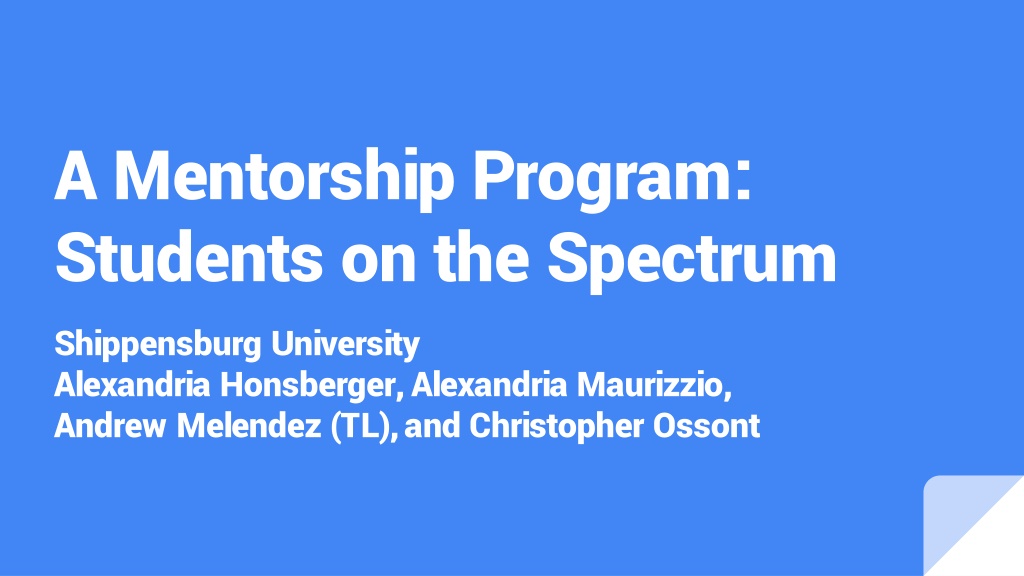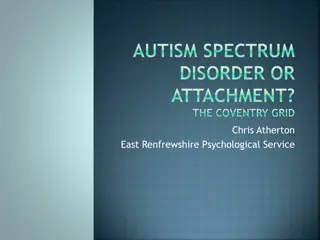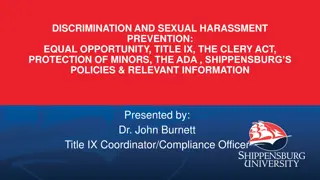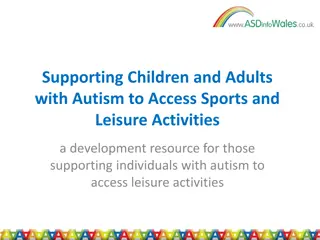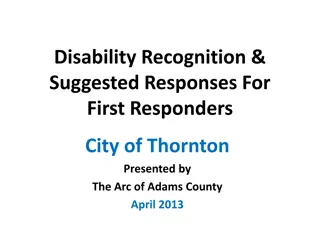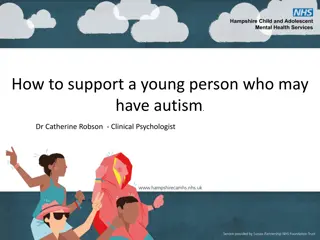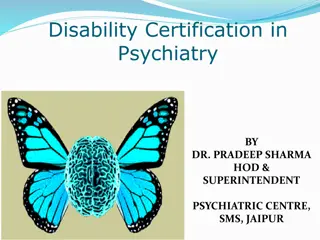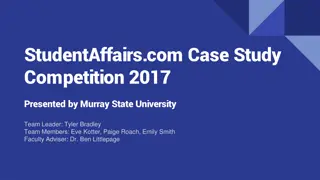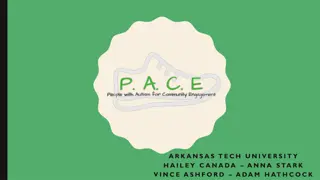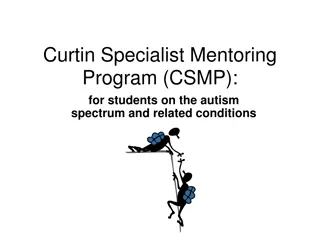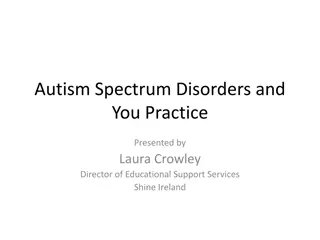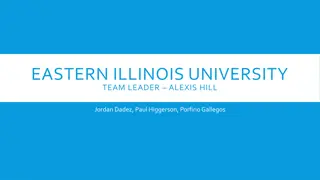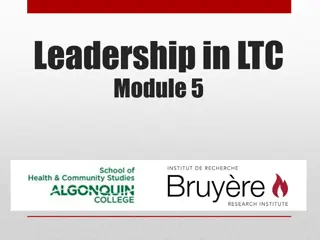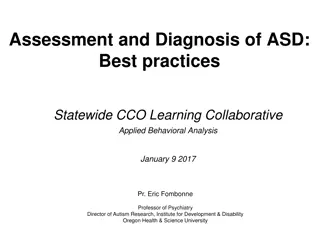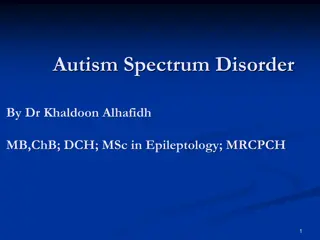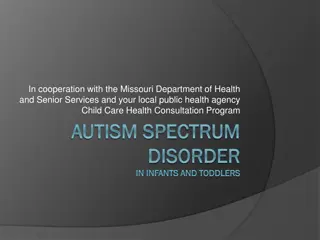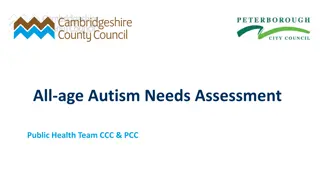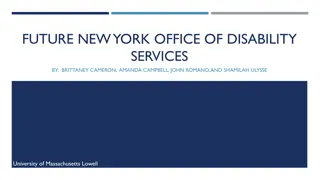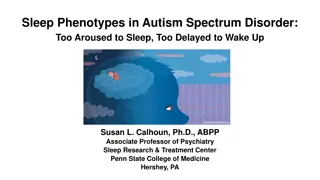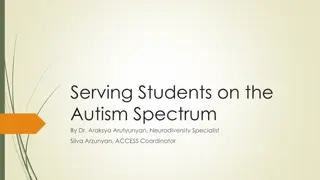Understanding Autism Spectrum Disorder: A Mentorship Program at Shippensburg University
Autism Spectrum Disorder, with its unique challenges and strengths, is a complex condition that affects social skills, communication, and behavior. This mentorship program at Shippensburg University aims to support students on the spectrum through person-first language and the social model of disability. The team explores current issues within the autism community, such as the debate over finding a cure and the use of Applied Behavior Analysis for treatment.
- Autism Spectrum Disorder
- Mentorship Program
- Shippensburg University
- Person-First Language
- Social Model of Disability
Download Presentation

Please find below an Image/Link to download the presentation.
The content on the website is provided AS IS for your information and personal use only. It may not be sold, licensed, or shared on other websites without obtaining consent from the author. Download presentation by click this link. If you encounter any issues during the download, it is possible that the publisher has removed the file from their server.
E N D
Presentation Transcript
A Mentorship Program: Students on the Spectrum Shippensburg University Alexandria Honsberger, Alexandria Maurizzio, Andrew Melendez (TL), and Christopher Ossont
Introduction: What is Autism Autism ( tiz m), or autism spectrum disorder Refers to a broad range of conditions characterized by challenges with social skills, repetitive behaviors, speech and nonverbal communications, as well as by unique strengths and differences (Autism Speaks, 2017) Autism Was First Mentioned by Hans Asperger (1944)
Person-First vs. Identity First (What We Will be Using) Person-First Language Identity First Language In the autism community, many self advocates and their allies prefer terminology such as Autistic, Autistic person, or Autistic individual because we understand that autism is an inherent part of an individual s identity. (Autistic Self-Advocacy Network, 2017). The language a society uses to refer to persons with disabilities, shapes its beliefs and ideas about them. Words are powerful; old and inaccurate descriptors perpetuate negative stereotypes and attitudinal barriers. When we describe people by their labels of medical diagnoses we devalue and disrespect them as individuals. In contrast, using thoughtful terminology can foster positive attitudes about persons with disabilities. (The Arc, 2017). The team has decided that we will use person-first language. We think it is good practice for students to self-identify however they deem fit. Examples: People with disabilities. She has a learning disability.
Social & Medical Models of Disability (What We Will be Using) Social Model of Disability Medical Model of Disability The social model of disability makes the important distinction between `impairment` and `disability`. Disability is shown as being caused by `barriers` or elements of social organization which take no or little account of people who have impairments. Disabled people`s inability to join in society is seen as a direct result of having an impairment and not as the result of features of our society which can be changed. The team has decided that we will use the social model of disability for the foundational framework throughout this presentation. Examples of Barriers: Prejudice and stereotypes Inflexible organisational procedures and Inaccessible information; Inaccessible buildings; and transportation. Moyne (2012).Social and medical models of disability. disAbility.ie
Current Issues Autism Community The Cure for Autism: Whether research funding should be going to finding a cure for autism is a contested issue within the community. Some individual believe that there is no need for a cure and that the differences someone has because of autism merely calls for acceptance and understanding. Others believe that finding a cure is important and necessary for highly impaired individuals with autism (Psychology Today, 2014). Ongoing Treatment: Many children with autism undergo Applied Behavior Analysis which, at it s foundation, is to assist children in understanding and modifying behavior in the context of environment (Autism Speaks, 2012). However, while some have seen improvements after undergoing ABA, some believe that this is rooted in a rejection of neurodiversity and wanting to fix people with autism (Spectrum, 2016).
Difficulties in College Understanding that students with autism will also bring with them opinions and ideas on treatment and their identity as an individual with autism is very important when trying to assist them and meet their needs. Some issues that students with autism might face on campus include: - Balancing the social aspect of completing group work for class - Finding a place to meet other individuals to form friendships - Assistance with daily living needs such as maintaining a schedule, prioritizing daily needs, and managing anxiety (Cullen, 2015)
What Other Institutions Are Doing Institutions across the country are working to integrate students with ADS, specifically those who are identified as High Functioning Autism (HFA), into the general population of students through mentorship programs and the use of various other aids. Because of the high appeal for these students, many schools must adapt their practices to fit the needs of these individuals (Hamilton, et al., 2016). Mentorship programs with peers that work with students based on interests (Suciu, 2014). Assigning academic coaches and counselors to each student (Walters, 2014). Meeting with academic strategists to assist in optimal student achievement (Walters, 2014). Assisting students to the ADA compliance standards (Walters, 2014).
Diagnosis Presently, we don t have a medical test that can diagnose autism. Instead, specially trained physicians and psychologists administer autism-specific behavioral evaluations. (How is Autism Diagnosed, 2017). In order to get a proper diagnosis, parents and doctors look at the following starting as early as three years old: Social behaviors such as lack of communication (verbal/nonverbal) and misuse of objects such as toys Failure to form words after 12 months , no words by 16 months Loss of speech Lack of expression (physical or non physical) These symptoms can all be checked by the Modified Checklist for Autism in Toddlers (M-CHAT) One of the most important things you can do as a parent or caregiver is to learn the early signs of autism and become familiar with the typical developmental milestones that your child should be reaching. (Learnign Signs of Autism,, 2017) (Austism Speaks, 2017)
College Campus: The Rise of Students on the Spectrum 1 in 68 children diagnosed with autism spectrum disorder (CDC, 2014) Increase in students on the spectrum calls for institutions to implement policies to accommodate students on the spectrum. Examples: Peer Mentors, Academic Coaches & Counselors, Academic Strategists (Walters, 2014). However, a lot of these programs emphasize neurotypical folks aiding students on the autism spectrum The issue is that they largely ignore the bonds and connections that students on the spectrum might have with one another. ADAAA (The Americans with Disabilities Act Amendments Act, 2009) provides protections for people with disabilities and prohibits discrimination against them in the workplace, school and other settings.
What We Would Like To Do We propose the development of a peer mentorship program which: Trains individuals to work with their peers on the spectrum to assist with transitioning into college life. Provide academic and residential services to individuals on the spectrum to assist in their growth and development. Work to get individuals who are part of the program (as mentees) to later become peer mentors, creating a self-sustaining program Increase awareness for individuals on the Autism Spectrum and help hold colleges/ universities accountable for their growth and development.
Mentorship Program: Navigate with Us DESIGN a sustainable mentorship program that empowers students on the spectrum and connects them with the appropriate resources ENGAGE students in activities to create positive social skill building grounded in student development theory Potential topics for the Mentorship Program (Bednarchyk, 2014) Organizational skills, following classroom rules, concentration on tasks, anxiety or sensory issues, trouble with taking notes, group projects
Goals & Rationale for Navigate with Us Empowerment Many programs that institutions are using are peer facilitated. However, the peers are often classified as neurotypical. While this may be helpful for students on the spectrum, we would like to broaden the peer connections and open mentorship opportunities up to upperclass students on the spectrum Confidence One of the symptoms of ASD is emotional disconnectedness. By emphasizing confidence as one of the goals for the program, we hope the mentors can provide tools for mentees to grow in their academic confidence. Academic Success By having upperclass mentors with ASD mentor first year students with ASD, we hope that the mentor will provide resources and tips to being successful in college. Graduation rates are low for folks on the autism spectrum, so the hope is that mentors willbe able to role model successful academic behavior to help mentees succeed. Celebrate Differences One of the overarching goals of Navigate with Us is to create a community that celebrates neurodiversity. We are consciously aware that in today s climate many folks are discouraged from being different. It is important that at institutions of Higher Education that we practice celebrating differences and creating safe spaces for all students. This program will specifically look at how we can celebrate neurodiversity --a movement to address uniqueness among students on the autism spectrum.
The Benefits: Personal Personal benefits from Navigate with Us will include gained skills that students with autism may or may not have access to outside of campus: The mentorship program will provide a safe space for students with autism to connect with peers (who may or may not be on the spectrum) about everyday issues they may encounter during their personal experiences on campus: Experiencing sensory overload at campus programs Understanding overstimulation in their residence hall Processing through performance anxiety experienced in the classroom Additionalpersonalbenefits gainedthroughthementorshipprogram include: Learningcommunication skills to properlycommunicatewith peers in multipletypes ofsettings Begin feeling comfortable with leisure and recreational activities on campus with experiences provided through the mentorshipprogram Conversations surrounding ADAAA (The Americans with Disabilities Act Amendments Act,2009) focusing on rights and entitlements for students with disabilities in workand school
The Benefits: Social Social benefits from the Navigate with Us will include a familiarization and comfortability on campus for students with Autism: The mentorship program will provide various social experiences for students focused on social skill building including: 1:1 conversations with peers focused on interaction and social development (empowerment) Comfortability participating in group activities such as round table discussions with peers and mentors in the program Initiating conversations in personal and group settings, and properly managing social anxiety Additionalsocial benefits gained throughthe mentorship program include: Properlylearninghow to navigate socially with others in new settings Discussing how to properlyhandle conflict within each student's respectiveresidencehall Learningsocialcues and how to properlyrespond to socialcues on campus
The Benefits: Academic Academic benefits from the Navigate with Us will include gained knowledge and understanding of resources available to students with autism on campus : The mentorship program will provide knowledge of a number of resources on campus as well as how to access resources on campus while still feeling comfortable enough to do so: Fully detailed synopsis of the Learning Center and resources available to students at the Learning Center such as tutoring, additional test taking spaces, and study skills workshops Conversations and personalized workshops surrounding themes such as goal setting, adjusting to new schedules, prioritization, and overall organization Processing through performance anxiety experienced in the classroom, and how to properly cope with outcomes of group projects, test, note taking, etc. Additionalacademic benefits gainedthrough the mentorship program include: Fulleducation session on FERPA (Family Education Rights Protection Act) providing rationale,understanding,and benefits Workshops on how to fully transition to college course load as wellas how to properly manage workload Conversations with peers about their academic transitions,prioritization,and organization methods
Things to Keep In Mind Confidentiality Statement Peer Mentor Training Mentee Orientation Provide clear instructions regarding the mentor/mentee relationship Asking students to repeat instructions (Attwood, 2007)
Budget Allocated & Timeline February - April 2017 Conduct thorough research on the needs of students with autism Set up task force made up of various campus partners Include: academic services, the counseling center and the health center A student to ensure that students with autism have a voice in the program. May 2017 - July 2017 Develop plan specific to students at the institution. Ask for feedback from campus partners and students involved in task force. August 2017 Begin recruitment for peer mentors Hiring of peer mentors Training of peer mentors September 2017 Launching of mentorship program December 2017 Assessment and evaluation of the program Feedback from students (mentees and mentors), campus partners, parents Budget The cost of the mentorship program would be relatively low. The only items that would need to be purchased are any supplies needed by the mentor as well as expenses relating to any social gatherings for students pairs (gift card to the on-campus coffee shop). Seeking funding from the university (about $2000) coupled with grants from outside sources could help to cover costs that may arise throughout the year.
Staffing The Assistant Director of Disability Services would work to take a lead on the Mentorship Program. With the assistance of the Graduate Assistant, they would plan the trainings for peer mentors, assist in carrying out the program, making adjustments and improvements periodically, and assess the program s success and students overall satisfaction. This person would also assist in keeping up with up-to-date research of best practices within the field. In regards to staffing, below is the organizational chart for the Office of Disability Services. The Graduate Assistant in the Office of Disability Services will be able to gain experience that is not always offered at universities. They would be assist with the student development portion of the program: assisting with the research, the training of peer mentors, and the assessment pieces. It was really important for the team to include a graduate student and allow them to learn how to best meet the needs of students with autism and gain experience that may not be offered in other areas of their graduate work.
Coming to college is a time for any student to become independent, make their own decisions, and practice full autonomy within their college experience. Parents of students with autism typically have a harder time letting go of their children, and are often afraid that their child will not receive the support they need to succeed. In order to bridge the gap between the students educational rights and autonomy, and a parents want to still continuously be involved, the following resources are provided through various outlets to help all stakeholders feel comfortable with the college experience and Navigate with Us. Resources & Parents Autism After 16: (http://www.autismafter16.com/) This is a website for parents of students with autism that are beginning to transition from one chapter of their life to the next. This online resource provides special support, resources, webinars, and chat rooms for parents of children with autism who are all enduring similar experiences. Autism Calendar: (http://www.sarnet.org/events/) This resource is a calendar published by the Autism Speaks Foundation. The calendar list events that can be filtered by specific areas, topics, and interest in order for parents of students with autism to meet one another, speak about commonalities amongst transition of their students, and form common communal bonds Parent University: (https://www.autismspeaks.org/resource/parent-university-0) Located in Maryland, Parent University was founded by a dedicated team of health professionals dedicated to the quality of life for students with Autism. Through Parent University, Parents are able to receive training and workshops focused specifically on ways to let go of their students, allowing them to create their own paths for their college experiences, and begin to develop their own autonomy, making decisions for themselves. Letting Go: A Parents Guide to Understanding the College Years : This is a text that is often given to parents of first year college students during orientation. This book focuses on tips and tricks to understanding the student perspective of the college years, as well as helping better understand their students specific journey. Although this text does not speak specifically about students with autism, this is a wonderful resource that can help any parent begin to transition alongside their student. (Coburn, 2009). Institutional Office of Disability Services: Although this is predominately a resource for students and not parents, the office will typically have resources and content available for parents upon request. Due to FERPA laws, the Office cannot discuss your student's academic records however, the office may serve parents as a good resource in terms of knowledge of a variety of other topics and dialogues. (Autism Speaks, 2017)
Neurodiversity Neurodiversity -the range of differences in individual brain function and behavioral traits, regarded as part of normal variation in the human population (used especially in the context of autistic spectrum disorders). Autism falls into this spectrum due to the fact that it is not classified as a mental illness but instead as a neurodevelopmental disorder This concept calls into question what we believe to be ill and healthy and brings the idea that because someone has a disability does not mean that they are sick (SOCIAL MODEL OF DISABILITY); in particular those individuals who are diagnosed and classified on the Autism Spectrum. Neurodiversity calls for a culture shift working to include the difference of individuals into social normativity and divert focus of what individuals with mental disabilities cannot do, but instead what they are capable of doing. (Ripamonte, 2016)
Celebrating Differences Differences are what make each person unique and their own, authentic, true-self. For some students, college could be the first time they are encouraged openly discuss differences as well as differing experiences. For these reasons, differences should be celebrated on campus. In order to create the safest space possible for students, below are some things to consider when celebrating differences on your campus. Use Inclusive Language- When working to create an open, caring, and safe space where everyone feels free to come together, discuss, and celebrate their own differences, as well as differences of their peers, it is important to consistently use inclusive language that makes everyone present feel welcomed and included. Using inclusive language is a key way to make everyone in the room feel valued, secure, and heard. Learn About Your Campus Resources- Understanding the resources that are available to individuals, as well as how to properly access the resources on your campus is important when celebrating differences. As a practitioner, you want to make sure that you are constantly able to provide resources to those in need or want. Take Time to Learn About Differences- In order to properly celebrate differences on campus, it is important to also learn about differences. Take time to educate yourself so that you can educate others, while advocating for those in which you are able to. Create an Open and Safe Environment- Create an environment where everyone feels welcomed and comfortable. From the physical space, to the programs happening around the space, and the energy inside the space, you want to make sure everyone feels safe. Set ground rules for success and keep them posted in your spaces. Everyone deserves a safe space, especially where they feel they can be themselves and be celebrated. (Paperclip Communications, 2008)
Impact on Student Affairs By establishing, carrying out, and assessing the Mentorship Program, we are able to hit on a number of the NASPA/ACPA Joint Competencies. Assessment, Evaluation & Research (AER): developing a program based on student need and using assessment tools and evaluations to progress the program. It is also important to use already-existing research to best guide our practice in meeting the needs of students with autism Law, Policy & Governance (LPG): understanding the current federal and state laws as well as health-related or institutional policies protecting or affecting students with autism. Organization and Human Resources (OHR): understanding how to use resources such as budget, and use already existing staffing efficiently. Social Justice & Inclusion (SJI): creating an ever-inclusive environment on campus by acknowledging and addressing the unique needs of students with autism. Advising and Supporting (A/S): supporting students with autism during their collegiate years, addressing crises as they occur, and partnering with other departments, organizations, and individuals to continue to better meet the needs of students with autism. (ACPA/NASPA, 2015)
References Autism Speaks, & Autism Intervention Research Network on Physical Health. (2015, May). Applied Behavior Analysis: A Parent's Guide. Retrieved from https://www.autismspeaks.org/docs/sciencedocs/atn/atn_air- p_applied_behavior_analysis.pdf Bednarchyk, K. (2014). Advising students with autism spectrum disorder. Retrieved from NACADA Clearinghouse Resource: http://www.nacada.ksu.edu/Resources/Clearinghouse/View-Articles/Advising-Students-with-Autism.aspx Celebrating Diversity and Welcoming Differences. (2008). Creating an Environment that is Welcoming and Safe for Everyone. Retrieved from https://careers.sewanee.edu/media/careers/toolbox/CelebratingDiversity.pdf Center for Disease Control and Prevention. (2014). Data and statistics. Retrieved from http://www.cdc.gov/ncbddd/autism/data.html Coburn, K. (2009). Letting Go: A Parents Guide to Understanding the College Years. Cullen, J. A. (2015). The Needs of College Students with Autism Spectrum Disorders and Asperger s Syndrome. Journal of Postsecondary Education and Disability, 28(1), 89-101. Devita-Raeburn, E. (2016, August 15). The controversy over autism's most common therapy. Retrieved from https://spectrumnews.org/features/deep-dive/controversy-autisms-common-therapy/
References Moyne, A. (2012). Social and medical models of disability. disAbility.ie. Retrieved from http://www.disability.ie/disability-ie- information-portal/site-sections/rights-legislation/185-society/538-social-and-medical-models-of-disability Ripamonti, L. (2016). Disability, diversity, and autism; philosophical perspectives on health. New Bioethics. 2 2(1), 56-70. Robison, J. E. (2009, October 12). The "Cure" for Autism, and the Fight Over It. Retrieved from https://www.psychologytoday.com/blog/my-life-aspergers/200910/the-cure-autism-and-the-fight-over-it Suciu, Mirela. (2014). UNE mentoring program for students living with autism spectrum disorders (ASDs). Journal of the Australia and New Zealand Student Services Association. (44). p. 55-59. Walters, E. (2014). With autism diagnoses on the rise, New York universities offer students help. The Village Voice. Retrieved from http://www.villagevoice.com/news/with-autism-diagnoses-on-the-rise-new-york-universities-offer-students-help-6441510
Thanks! Contact us: Andrew Melendez (Team Leader) Housing and Residence Life 1871 Old Main Drive Shippensburg, PA 17257 armelendez@ship.edu
